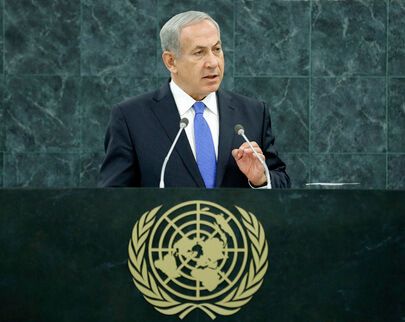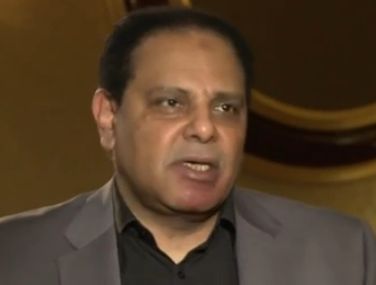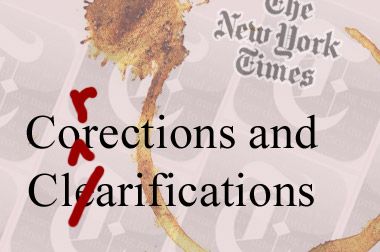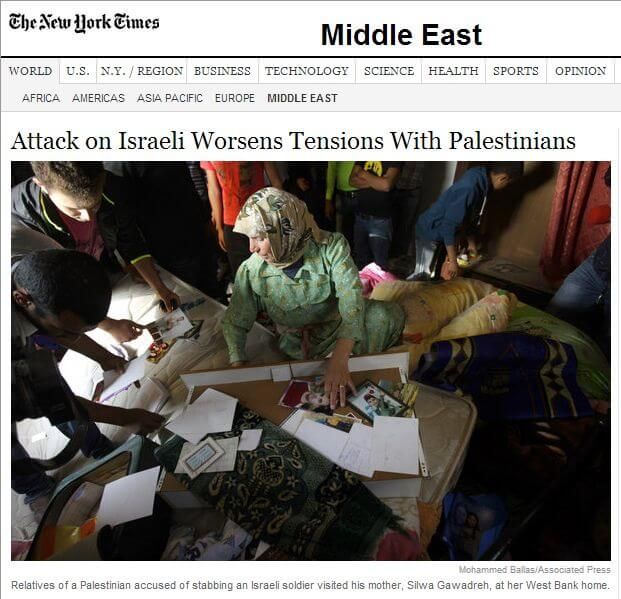Israel, Iran, and the Gray Lady’s Vendetta

This was absolutely the single biggest bone of contention among HonestReporting readers.
In September, world leaders gathered in New York for the start of the UN General Assembly. Amid signs of a thaw in US-Iran relations, the paper featured a steady parade of news and commentary pooh-poohing Israel’s legitimate fears of Iran’s nuclear program.
Quite a few readers went so far as to imply that the Gray Lady was either acting as a mouthpiece for the Obama administration or engaged in a personal vendetta against Prime Minister Benjamin Netanyahu. Or both.
As Times of Israel reporter Avi Issacharoff wrote at the time:
And still, some American media outlets have evidently been mesmerized by President Hassan Rouhani’s smile. The New York Times seems to be directing a campaign against Prime Minister Benjamin Netanyahu, who has said sanctions on Iran must not be removed and warned about the Islamic Republic’s true intentions. Certain Western journalists are possibly driven by the hope — and, perhaps, some degree of naivety — that the crisis will not require the use of force.
But the anti-Netanyahu campaign misses (or ignores) the fact that the wary Israeli government, not surprisingly, enjoys the support of many Arab countries — including Egypt, Saudi Arabia, and the UAE — which are not naive about Iran.
And Israel HaYom‘s Dror Eydar added:
The Times has a long history of supporting even the faintest of hopes when it comes to reconciliation with ruthless dictators.
 What fueled these perceptions?
What fueled these perceptions?
- A staff-ed confusing Israeli wariness with malice.
- A staff-ed accusing Netanyahu of deliberately trying to sabotage the nuclear talks.
- A staff-ed condescendingly implying that Israel, Turkey and the Saudis are rebelling against the American master.
- A staff-ed setting up Israel to be the fall-guy for the collapse of US-Iran diplomacy.
- A staff-ed suggesting that reaching an agreement with Iran is more important than the contents of the deal.
- A staff-ed describing Israeli objections to the interim deal as one of the “perils ahead.”
- A staff-ed describing Netanyahu’s objections to an interim deal as “hysterical opposition.”
- Roger Cohen‘s condescending take on “Bibi’s Tired Iranian Lines.”
- Roger Cohen‘s dismissive view of Israeli concerns.
- Tom Friedman claiming that Congressional opposition to the White House on Iran stems “from a growing tendency by many American lawmakers to do whatever the Israel lobby asks them to do . . .”
- Tom Friedman trivializing Israeli concerns by contrasting “Bibi crazy” with “Obama cool.”
- Tom Friedman‘s condescending take on concerned American allies.
- Jodi Rudoren‘s analysis that went overboard on Netanyahu’s political isolation. (This article caught a second wind of buzz because the paper corrected a description of Sara Netanyahu. Rudoren also sent the prime minister’s wife a personal apology.)
Looking back on it all, readers wondered: Did the the Times take the opportunity to hit back at Bibi after his UN speech called out the NY Times? If so, was doing so on such an existential issue an appropriate way to settle scores? How else would the Times explain the insultingly dismissive tone of all those commentaries? And why didn’t the Times bring more balance to its op-ed section?
Conspiracy Theorist Joins Editorial Board

In October, the Times announced the expansion of its editorial board. Newest members of interest to Mideast watchers include Israeli columnist Shmuel Rosner, former PA cabinet minister Ali Jarbawi, and the Iranian-born Professor Vali Nasr.
But also joining the board was an Egyptian writer who has spread anti-Israel conspiracy theories, Alaa Al Aswany.
HonestReporting looked into Aswany’s history. In a nutshell, the Times is associating itself with a talented, award-winning writer who also:
- Refused to allow his book to be translated into Hebrew or sold in Israel.
- Claimed baselessly that Israel meddled in Egypt’s revolution.
- Denied a long history of Arab anti-Semitism.
What about Aswany’s right to express himself? asked one reader who wrote of Taking a Bullet for Alaa Al Aswany’s Freedom of Speech. As with Joseph Levine and Ian Lustick, Aswany’s entitled to his views. But that doesn’t mean the Times has to give a proven conspiracy theorist a plum seat on the editorial board.
Correcting the Record
 Journalists are fallible, lines of communication get crossed, and too many editors will inevitably spoil something. And who hasn’t been plagued by computer glitches or an embarrassing typo? Mistakes happen. That’s why newspapers correct the record.
Journalists are fallible, lines of communication get crossed, and too many editors will inevitably spoil something. And who hasn’t been plagued by computer glitches or an embarrassing typo? Mistakes happen. That’s why newspapers correct the record.
But there’s an unfortunate reality to the corrections. The majority of people reading an erroneous “fact” will never know that hours (or days) later, a correction was made (except in very unusual circumstances).
And so it was in August, when Tom Friedman erroneously stated that Yitzhak Rabin’s assassin, Yigal Amir, was a settler. (Amir lived in Herzliya.) The miscue was unfortunate (the Times had previously corrected the very same error), but also forgivable, because A) in the context of Friedman’s column, it was a relatively minor point, and B) the original correction was made eight years ago.
But it’s also fair to ask (as HonestReporting did in 2012), If the NY Times Posts a Correction, Does it Make a Sound?
(Friedman’s column also mistakenly stated that the 60’s rock star, Eric Burdon, had boycotted Israel. That assertion was based on a report in The Independent, but Friedman missed the UK paper’s followup. The Independent’s contradictory articles apparently arose from either a miscommunication or disagreement between Burdon and his manager. Perhaps Burdon foreshadowed the mess when he sang Don’t Let Me Be Misunderstood.)
The Gray Lady did the right thing, fixing the factual faults (Corrections – August 8). Ironically, among the other articles corrected that day was an unrelated piece by bureau chief Jodi Rudoren. Her dispatch on Israeli settlements misstated the State Department’s position.
The paper’s global reach compounds the headaches of correcting the record. Lots of papers republished the Friedman and Rudoren pieces but not necessarily the clarifications. So if the Sidney Morning Herald or Pittsburgh Post-Gazette never issued the proper corrections, where does the buck stop?
Fumbled Photo Flub
Images are supposed to do more than simply illustrate a story. Effective photographs and graphic illustrations help readers zero in on the essence of the article.
Thus, when Eden Atias, an 18-year-old soldier traveling to his base was stabbed to death by a Palestinian aboard a bus, one would have expected to see funeral images or a photo of Atias himself. As a gesture of respect, press photographers in Israel have an understanding not to take pictures of dead bodies at terror scenes (that’s a separate debate); however Attias’s bloodstained bus seat wasn’t considered out of line.
So how was the Times’s coverage illustrated? With a sympathetic photo of — who else? — the terrorist’s mother.
(This was actually the second time this year the Times used a photo of a Palestinian terrorist’s mother inappropriately.)
In any event, the image of Silwa Gawadreh receiving visitors touched a raw nerve. Outraged by the misplaced sympathy for the terrorist, HonestReporting readers flooded the Times with emails demanding an explanation. And they grabbed the paper’s attention. Jerusalem bureau chief Jodi Rudoren wrote to one reader on Facebook:
. . . I spoke to the international photo editor about it. He and I agree it was not the best choice (I did not know about it until the other reader wrote me), and that for sure it should have at least been paired with a picture of the victim.

Public editor Margaret Sullivan concurred, and went on to quote two senior editors expressing their mea culpas:
Hundreds of readers wrote to me in recent days to protest the prominent use of a photograph that accompanied an article in The Times last Thursday.
The photograph was an emotional and sympathetic portrait of a distraught Palestinian woman, whose son had killed an unsuspecting young Israeli soldier on a public bus. Although it was a powerful image (in fact, partly because it was such a powerful image), it was a poor choice, failing to put the focus where it belonged . . .
The selection of the Palestinian mother’s image with the article was an effort to achieve balance, but such an effort was not appropriate in this case, Ms. McNally said.
The chest-beating was certainly impressive, but the Times hasn’t changed the photo. Sullivan followed up, quoting Philip Corbett, the associate managing editor for standards. (HonestReporting received a similar response directly from Corbett):
He explained that “except to correct factual errors, we very rarely change or delete published content. The stories that remain accessible through our website constitute our electronic archive of what The Times has actually published, parallel to the print and microfilm versions of our archive that we have always maintained . . . Other than for factual errors, if we routinely went back into a story published days, weeks or years earlier – rewriting, re-editing, adding or deleting photos or other elements – pretty soon our archive would cease to be an archive at all.”
The net result is that the image remains online, a lasting memorial to the Times’s false balance and misplaced sympathy.
* * *
Be sure to see the 2013 Dishonest Reporting runner up winners.
We covered a lot of ground in 2013. And with help from readers, we’ll continue to monitor and hold the media to account in 2014. We rely on supporters like you to help us produce material like this. Please consider donating by clicking here.
HonestReporting’s Simon Plosker discussed the awards with Radio TLV1. Simon joined in the “Politely Rough” show at the 42:30 mark. Click to listen.
(Image of Lustick via YouTube/POMEPS, Netanyahu via UN News & Media, Aswany via YouTube/Al Jazeera English)
.



